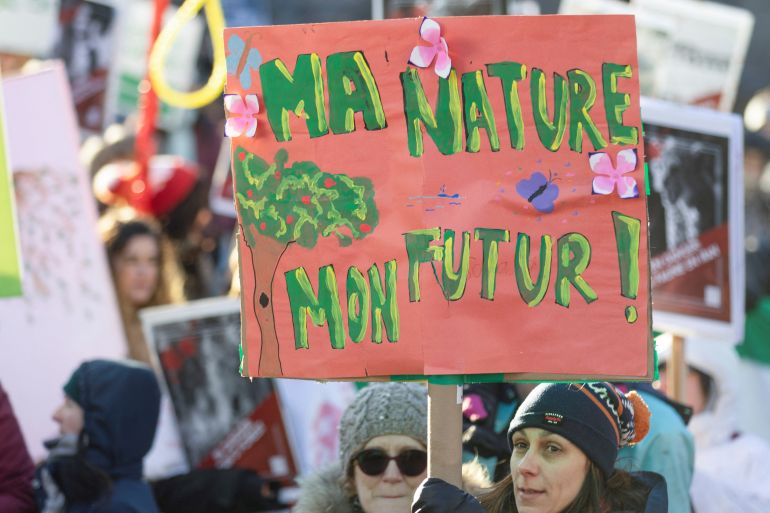COP15 was a success — here’s what needs to happen next
The historic global agreement at the UN conference to halt and reverse biodiversity loss by 2030 is just the start.

Our hopes of reversing the global crisis facing the natural world remain alive. The COP15 agreement in Montreal, Canada, on a Global Biodiversity Framework (GBF) earlier this month commits countries to implementing and funding ambitious global targets and national plans that can halt and reverse the loss of biodiversity, and put us on course for a nature-positive world.
By setting a target to conserve at least 30 percent of land, freshwater and ocean globally by 2030, and restore 30 percent of degraded land, while respecting the rights and leadership of Indigenous peoples and local communities, governments have chosen the right side of history.
Keep reading
list of 4 itemsAfter the Hurricane
World’s coral reefs face global bleaching crisis
Why is Germany maintaining economic ties with China?
However, we will only truly make history if we deliver on the promise made in Montreal.
When delegates first gathered for the convention there, hopes were high that negotiators could secure a “Paris Agreement for nature”. Just as the Paris Agreement targets guided subsequent climate action, the GBF and its goals can now drive action to restore nature. This agreement must be the launch pad for action from governments, business and society to transition towards a future with more nature, not less.
One of the most contentious issues throughout the negotiations was the finance package to support conservation efforts globally, and particularly in developing countries. It is therefore a major achievement that negotiators managed to forge an agreement that could pave the way for the mobilisation of at least $200bn a year in nature financing by 2030. The agreement commits signatory governments to eliminating subsidies to fertilisers and other products and practices harmful to nature.
The GBF also accords full recognition to the rights and roles of Indigenous peoples and local communities. Indigenous peoples make up just five percent of the global population, but they safeguard 80 percent of the world’s remaining biodiversity. It was vital that they were recognised in the agreement and their rights protected.
However, the success of this agreement cannot be taken for granted. The framework it creates could yet be undermined by slow implementation and if the requisite finance is not mobilised. While every country will have to increase domestic investments to support the increased ambition, it is important that more resources flow from the richer nations to the Global South where biodiversity is higher and means to conserve it lower.
Wealthy nations do not have a good track record when it comes to delivering on promises to provide finance to support the planet, a challenge that has also hurt the fight against climate change. And individual countries are yet to make definite commitments — on finance, on ending subsidies and on other aspects of the framework.
We must now see the immediate implementation of this agreement. No excuses, no delays – nature loss is rapidly becoming a fundamental threat to our prosperity, equality, social cohesion, health and wellbeing. And without nature’s ability to absorb and store carbon from the atmosphere we won’t be able to stay below 1.5C of global warming.
Governments must update national biodiversity strategies and action plans (NBSAPs) as soon as possible, spelling out their targets and promises in line with the new global framework. It will be vital to hold governments accountable for the pledges they make. Leaders will reconvene in four years to take stock of whether governments are on course to meet their targets.
To be sure, the framework does have weaknesses. Decisions on some of the critical indicators needed to measure the state of biodiversity were delayed. For example, it lacks a hard numerical target for reducing the footprint of economic production and consumption.
The framework also fails to ensure a mandatory “ratcheting mechanism” under which governments would be required to increase action if targets are not met. There is weak language in the agreement in critical areas such as the protection of intact ecosystems.
Still, there is reason for cautious optimism. Developed countries have a clear responsibility to support developing countries in their efforts. It is encouraging to see the development of initiatives such as the NBSAP accelerator partnership, the High Ambition Coalition for Nature and People, and the Leaders’ Pledge for Nature to develop national biodiversity finance plans. These platforms could increase cooperation between the rich world and developing countries.
Business also needs to accelerate its engagement. The private sector increasingly recognises impacts on and dependencies from nature, and that it cannot thrive with nature in decline. Coalitions such as Business for Nature and the Finance for Biodiversity pledge have demonstrated the willingness of leading voices in the private sector to take action. They will, increasingly, have strong national regulations to comply with and to underpin their efforts.
COP15 has given us an agreement that aims at healing our relationship with nature. We must nurture the seeds planted in Montreal. Only then will we feel comfortable looking into the eyes of our children, grandchildren and the world’s youth.
The views expressed in this article are the author’s own and do not necessarily reflect Al Jazeera’s editorial stance.
